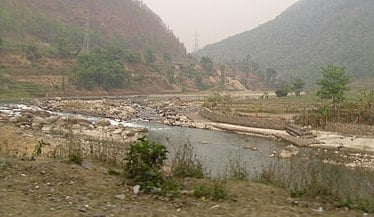Kosi River

The Kosi or Koshi (Hindi: कोसी, kosī, Nepali: कोशी, koshī) is a trans-boundary river which flows through Tibet, Nepal and India. It drains the northern slopes of the Himalayas in Tibet and the southern slopes in Nepal. From a major confluence of tributaries north of the Chatra Gorge onwards, the Kosi River is also known as Saptakoshi (Nepali: सप्तकोशी, saptakoshī) for its seven upper tributaries. These include the Tamor River originating from the Kanchenjunga area in the east and Arun River and Sun Kosi from Tibet. The Sun Koshi’s tributaries from east to west are Dudh Koshi, Bhote Koshi, Tamakoshi River, Likhu Khola and Indravati. The Saptakoshi crosses into northern Bihar, India where it branches into distributaries before joining the Ganges near Kursela in Katihar district.[1]
The Kosi River is 720 km (450 mi) long and drains an area of about 74,500 km2 (28,800 sq mi) in Tibet, Nepal and Bihar.[2][3] In the past, several authors proposed that the river has shifted its course for more than 133 km (83 mi) from east to west during the last 200 years. But a review of 28 historical maps dating 1760 to 1960 revealed a slight eastward shift for a long duration, and that the shifting was random and oscillating in nature.[4]
The river basin is surrounded by ridges which separate it from the Yarlung Tsangpo River in the north, the Gandaki in the west and the Mahananda in the east. The river is joined by major tributaries in the Mahabharat Range approximately 48 km (30 mi) north of the Indo-Nepal border. Below the Siwaliks, the river has built up a megafan some 15,000 km2 (5,800 sq mi) in extent, breaking into more than 12 distinct channels, all with shifting courses due to flooding.[5][6] Kamalā, Bāgmati (Kareh) and Budhi Gandak are major tributaries of Kosi River in India, besides minor tributaries such as Bhutahi Balān.[7][8]
Its unstable nature has been attributed to the heavy silt it carries during the monsoon season, and flooding in India has extreme effects.[9] Fishing is an important enterprise on the river but fishing resources are being depleted and youth are leaving for other areas of work.[10]
